A therapeutic environment is one in which housing and healthcare services are tailored to the individual needs of each resident, utilizing a social model of care rather than the medical model found in many eldercare facilities. A therapeutic environment recognizes that people with dementia deserve and need kind and supportive care focused on dignity, respect, and autonomy. This approach to dementia care considers the consequences of the built environment on the well-being of residents with dementia (Rijnaard et al., 2016).
A therapeutic environment should include the following practices:
- Reduce risks, unobtrusively.
- Allow people to see and be seen.
- Reduce unhelpful stimulation.
- Optimize helpful stimulation.
- Support movement and engagement.
- Create familiar places.
- Provide opportunities to be alone and with others.
- Provide links to the community. (Fleming et al., 2020)
In a comparison of “regular” specialized care units and small, homelike specialized care units that utilized a therapeutic approach, clients in homelike care units in The Netherlands needed less support with activities of daily living, were more socially engaged, showed less agitation over time, and needed less psychotropic medication and physical restraints. Residents of the small, homelike units awarded higher scores to their quality of life, showed less negative affect and better social relationships, and were more engaged in activities (Kok et al., 2016).
In 2021, the Joint Commission established an assisted living accreditation program to bring consensus-based standards to facilities nationwide. The standards address the environment, staffing, emergency management, dementia care, medication management, provision of care and services, and process improvement (JC, 2021).
Joint Commission accreditation requires accredited facilities to track and report on five standardized performance measures:
- Off-Label Antipsychotic Drug Use
- Resident Falls
- Resident Preferences and Goals of Care
- Advanced Care Plan/Surrogate Decision Maker
- Staff Stability (JC, 2021)
Dementia Friendly Care
Dementia friendly means more than sticking a green leaf above a hospital bed. It means appreciating that someone with dementia may have a problem with their balance or sight but may have a better memory in some respects than you or me. It means respecting the brilliance with which those same people still sing, identify a little-known shrub, or whittle a piece of wood.
Alzheimer’s Disease International, 2019
Dementia friendly care focuses on the experience of people with dementia and advocates for positive attitudes and behaviors toward dementia. It treats people with dementia and their caregivers with dignity and respect and calls for an end to stigma. It seeks community support for people affected by dementia so they can “live well with dementia” (ADI, 2015).
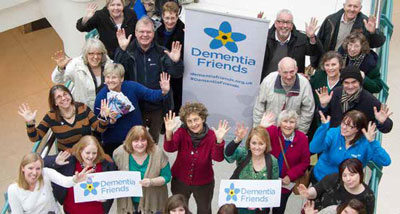
Source: Courtesy Alzheimer’s Disease International.
The Dementia Friendly Community movement has demonstrated, time and time again, that there is so much we can do to make life for those who have dementia and their caregivers immensely better by making them feel supported, loved, and understood by our society and, wherever possible, by empowering them in every aspect of dementia activity, including advocacy. This makes a marked contrast to feeling shunned, hidden, or shamed (ADI, 2019).
Person-Centered Care
Person-centered care, an important component of dementia friendly care, relies on the skill, training, and knowledge of an organization and its caregivers. Organizational policies and procedures and caregiver practices are built around the needs and preferences of the resident, the care professional, and family caregivers.
Person-centered care is flexible, creative, and supportive. It promotes inclusion of the people living with dementia and their caregivers in care and treatment decisions, with the aim of increasing positive outcomes (Handley et al., 2015). Person-centered care is the opposite of task-centered care. In dementia care, it involves practices aimed at helping residents establish relationships and be treated as individuals with their own life history and interests (Desrosiers et al., 2014).
An innovative person-centered approach called Green Care Farms has been developed in The Netherlands, where daycare services and 24-hour nursing home care is available for people with dementia. Green Care Farms offer a selection of activities, including caring for plants and animals, and encourages residents to engage in tasks suited to their level of dementia and physical capabilities (de Boer et al., 2015).
In a study on daycare services at Green Care Farms, it was suggested people deliberately chose Green Care Farms because of their dislike of the institutional environment of regular daycare facilities. Green Care Farms are a unique type of small-scale facility that provides nursing home care for people with dementia in a home-like environment on the terrain of a farm. Green Care Farms were perceived as more useful for clients, more meaningful, and providing more opportunities to be physically active and to go outdoors (de Boer et al., 2019).
This preference is seen in residential facilities as well. In a case study conducted for Alzheimer’s Disease International, researchers focused on a cost-benefit analysis of outdoor spaces at an assisted living facility in Tennessee. The study assessed environmental features related to outdoor satisfaction. Residents reported satisfaction with outdoor areas, feeling better after being outdoors, and satisfaction with the amount of time spent outdoors. Costs were estimated for improvements to four features most often described as problematic: doorways, unsafe walkways, inadequate seating, and lack of shade. Links were drawn between a resident’s satisfaction with the outdoor spaces, their well-being, and their willingness to refer others to the facility. Financial benefits to the facility included increased annual income resulting from increased revenue from new referrals and decreased spending on marketing (Fleming et al., 2020).
Staff as Part of the Environment
Blending staff into the assisted living environment can be challenging. There are no “magic bullets” aimed at changing staff care practices to improve resident outcomes. Although person-centered care is increasingly accepted as a philosophical approach in residential care, it is not clear whether staff and organizational practices are changing, or whether proposed changes are improving quality of care or resident outcomes (Low et al., 2015).
The importance of having sufficient, competent staff to ensure quality of care is a major concern. High turnover, job dissatisfaction, and difficulties recruiting qualified staff are common challenges in all facilities that care for frail older adults. Many factors impact job satisfaction with quality care, which can make it difficult to effectively blend staff into the assisted living environment. These can include:
- Unclear roles and functions
- Heavy workloads
- Demanding work schedules
- Difficult ethical issues
- Job strain, stress of conscience, and burnout (Vassbø et al., 2019)
The Physical Environment
Careful consideration of the physical environment in residential care eases the transition for new residents (ADI, 2020). Unfamiliar, chaotic, or disorganized environments—whether at home or in a residential care facility—are stressful and can cause anxiety, disorientation, and behavioral problems.
A well-designed physical environment can have a positive impact on people with (and without) dementia. The facility layout, sound levels, and access to outdoor areas can improve sleep, orientation, activity, and overall well‐being (Nordin, McKee, Wijk, & Elf, 2017). People with dementia rely on environmental cues to support them physically, cognitively, and emotionally.
For people with dementia living in a residential care facility, most of their time is spent inside. They depend on the physical environment to support their activities and social interactions. A high‐quality physical environment encourages well‐being, safety, and independence and supports person‐centered care by creating a sense of home (Nordin, McKee, & Wallinder, 2017).
Thoughtfully designed indoor spaces can reduce unwanted behaviors and enhance a sense of well-being. This can include:
- Open plans, automatic doors, and elevators in buildings to facilitate resident movement in communal areas and between floors (Nordin, McKee, & Wallinder, 2017).
- Public spaces and places for semi-private interactions.
- Spaces clean and free of odors.
- Sunlight, ventilation (no dark nooks and crannies).
- Views to the outside.
- Safety devices in apartments and dining rooms (Nordin, McKee, & Wallinder, 2017).
- Spaces that cue specific behaviors (activity kitchen, art and music therapy area, bistro/bar, rummaging room, library, coffee shop/internet café, quiet room, living room).
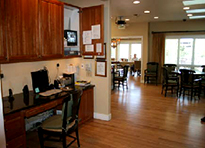
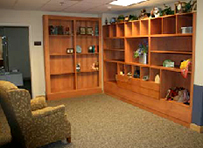
Left: Residential-looking, smaller-scaled nurses’ station. Right: a room for rummaging. Source: Campernel & Brummett, 2010. Used with permission.
Thoughtfully designed outdoor areas are just as important. This can include:
- Arranging outdoor spaces to resemble a natural community.
- Creating continuous circulation routes with looping pathways, rest stops, and areas of interest.
- Including residents in the design of new features such as walking paths and gardens.
- Creating safe, purposeful, heated, and accessible outdoor areas.
- Offering attractive landscaping, gardens, and pleasing views. (Rijnaard et al. 2016)
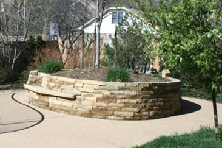
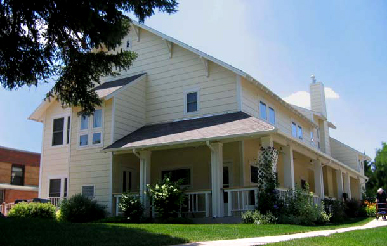
Left: Safe, looping wandering paths with areas of interest along the way. Right: A memory-care facility with home-like outdoor porch area for seating and reflection. Source: Campernel & Brummett, 2010. Used with permission.
Elements of the physical environment that support residents’ cognitive functioning need to be considered in the design process and should also be given special attention in existing facilities. Knowledge regarding how the physical environment can support older people’s cognitive health allows care staff to improve care practices (Nordin, McKee, Wijk, & Elf, 2017).
Safety and Security
Assisted living facilities must provide an appropriate environment, adequate, trained staff, and plan for adverse events. These are essential components of a safe and secure environment. People with dementia need to feel safe (and be safe) without the use of physical and chemical restraints.
The National Patient Safety Foundation defines patient safety as “freedom from accidental or preventable injuries or harm produced by medical care.” This includes preventing elder abuse and examining the factors that foster an unsafe environment for both residents and staff. Administrators are legally and morally responsible for ensuring that quality and safety standards are met (Myhre et al., 2020).
The National Patient Safety Foundation says a “culture of safety” should include these elements:
- An established and sustained safety culture.
- Centralized and coordinated oversight of patient safety.
- Common safety metrics that reflect meaningful outcomes.
- Adequate support for the healthcare workforce.
- Client and family partnerships focused on the safest care.
- Technology that is safe and optimized for patient safety. (NPSF, 2015)
Although assisted living was originally conceived to provide non-medical, independent living in a home-like environment, nearly half of people currently residing in an assisted living facility in the United States have some sort of dementia. This means that sensory and motor changes such as reduced hearing, loss of visual acuity, and decreased strength and flexibility are common. Judgement and decision-making are also affected by dementia, making safety an important and ongoing concern.
In a well-run facility, simply receiving care can be beneficial for a person with dementia. Having regular contact with a well-trained caregiver can provide a sense of safety and security. A well-designed and well-run facility is secure, comfortable, and predictable; it is a place where residents feel at ease—a place where you can be who you are and feel connected with like-minded people (Rijnaard et al., 2016).
Assisted living facilities, however, vary widely in the number and structure of available services. Some facilities have 24‐hour on‐call assistance as well as on‐call nursing assistance—others do not. Some facilities coordinate care with external home health agencies and allow residents to hire personal care assistants externally (AGS, 2020).
A safe environment also includes features such as proper flooring, handrails, and adequate lighting. The table below illustrates some common safety hazards and measures to help make the environment safe and secure. Interventions should be tailored to match the specific circumstances.
Measures to Promote Safety and Security | ||
|---|---|---|
Safety issue | Possible consequence | Intervention |
Wandering | Getting lost, exposure to environmental hazards. |
|
Cooking without supervision | Fire, injury |
|
Falls | Injury |
|
Poisoning | Sickness or death |
|
An often-overlooked safety issue in eldercare facilities is elder abuse. In a survey of patient safety in 12 nursing homes in Norway, researchers sought to understand elder abuse and neglect as an important aspect of safety and security. They noted three major abuse themes:
- Abuse from co-residents—often described as “a normal part of nursing home life.” Resident-to-resident aggression appeared to be so commonplace that care leaders perceived it as normal and had no strategy for handling it.
- Abuse from relatives—often treated as a private affair. A relative engaging in abusive behavior when visiting a resident was described as a “difficult issue” but something that should be kept between the resident and the relative.
- Abuse from direct-care staff—considered “an unthinkable event.” Staff-to-resident abuse was difficult to talk about and viewed as not being in accordance with the leaders’ trust in their employees. (Myhre et al., 2020)
The COVID-19 pandemic has uncovered huge gaps in the safety and security of residents in nursing homes and assisted living facilities. As of October 15, 2020, an average of 1 death occurred among every 5 assisted living residents with COVID-19, compared with 1 death among every 40 persons in the general population with COVID-19 in states with available data (Yi et al., 2020).
Schedules and Routines
Schedules and routines are an important part of everyone’s life. However, when someone enters a facility, their usual routines are interrupted and altered. This creates a tension between the necessary institutional routines and the clients’ personal habits and needs (Rijnaard et al., 2016).
Schedules and routines are often organized around the convenience of the staff, and schedules can change dramatically from day to day. This is difficult for people with dementia because they rely on a predictable routine for orientation and to know what to expect. Routines also give the caregivers a benchmark for evaluating a person’s behavior. Caregivers responsible for maintaining a routine schedule must be flexible. People with dementia tend to be slow, so caregivers must allow ample time for meals and activities. Attempting to rush a resident often precipitates aggressive behaviors that frustrate both parties.
A schedule for someone with dementia should:
- Be carefully planned.
- Consider a person’s capabilities and preferences.
- Maintain familiar routines and schedules.
- Maintain regular dental and healthcare appointments.
- Allow plenty of time.
- Note the effects of changes in routines.
- Consider physical issues that disrupt routines such as pain, fatigue, or illness.
Staff Training
Many people with dementia are advocating for the phasing out all institutional care, the cessation of segregation in locked dementia units, and for all healthcare staff to be fully competent in dementia as well as disability.
Alzheimer’s Disease International, 2019
Lack of staff training is a significant problem in the assisted living environment, and in many states, staff qualifications are not mandated. Many states stipulate direct care worker training content, but they may not have enough required training hours (or any specific required training hours) to cover the designated content. Staffing requirements for assisted living facilities also varies by state. If licensed care is needed, some states allow it to be provided remotely (Trinkoff et al., 2020).
No state mandates training related to the role of a personal care assistant, such as their role on the care team, appropriate boundaries, or encouraging client independence in self-care and other activities. There is no standard training for direct care workers in assisted living that allows them to fully grasp their role in nonmedical settings. There is no standard training for these workers on empowering clients to maintain function, health, and well-being (Kelly et al., 2018). Barriers to implementing improvements in training include cost, senior leadership resistance, low-innovation culture, low staff education, and high staff turnover (Low et al., 2015).
Staff Training in Assisted-living Residences (STAR) is a program developed specifically to educate staff about resident behaviors using a structured, individualized approach. First and foremost, staff are taught to understand how dementia affects the brain and how these changes affect memory, mood, and behaviors (Teri et al., 2010).
During training, staff are encouraged to develop the following skills:
- Be a good, caring listener.
- Be calm, consistent, and flexible.
- Be patient and supportive.
- Be honest and respectful.
- Be humorous. (Teri et al., 2010)
The STAR program is structured but flexible. It is designed to teach direct care staff in assisted living strategies and techniques to improve the care of residents with dementia. Staff are taught to use the ABC approach to address behavioral problems in residents with dementia (Teri et al., 2010).
The ABC or problem-solving approach encourages caregivers to look for and address the root cause of a behavior—usually with environmental modification, medication management, or caregiver training. This approach encourages caregivers to identify critical points for intervention based on observing the antecedent (activator), behavior, and consequence (A, B, C) of a challenging behavior.
- Antecedent (activator)—what caused the behavior?
- Behavior—what is the behavior?
- Consequence—what are the consequences of the behavior?
The ABC approach is particularly effective when successful strategies are shared by staff, caregivers, and family members. The ABC method helps staff and caregivers understand when and how often a behavior occurs and offers the opportunity for discussion and planning.
Proper Staffing
Throughout the United States, about half a million people work in an assisted living facility. Among the nearly 1.5 million nurses and social workers in long-term care, about 300,000 are employed full-time at an assisted living community. Assisted living communities also hire part-time nursing and social work employees, or contract with other organizations to coordinate nursing and social work services in the community. The breakdown of full-time nursing and social work employees in assisted living is as follows (NCAL, 2020):
- 83.3% aide
- 9.9% licensed practical or vocational nurse
- 6.1% registered nurse
- 0.8% social worker
In the United States, aides provide nearly 85% of the nursing care to residents. On a typical day in residential care, the average time spent with a resident each day by nursing staff (overwhelmingly aides) is about two-and-a-half hours. The average staff hours per resident or participant per day in a residential care facility is 19 minutes. The average social work hours per resident is just 2 minutes per day (Harris-Kojetin et al., 2019).
In Florida, every assisted living facility is under the supervision of an administrator who is responsible for its operation and maintenance, including the management of staff and the provision of adequate care to all residents. Facilities must employ direct care staff. A staff member who has completed courses in first aid and cardiopulmonary resuscitation must be always in the facility (ASPE, 2015).
In nursing homes, most direct patient care is provided by certified nursing assistants (CNAs), who are subject to federal regulations and are trained and certified through state nurse aide registries or boards of nursing. There is a mandatory federal curriculum for CNA training (Trinkoff et al., 2020).
Assisted living facilities by contrast mostly employ unlicensed direct care workers to provide personal care and daily services. Direct care workers are not subject to regulation by most nurse aide registries or boards of nursing. Training hour requirements are diverse across states, with 17 states requiring direct care workers to be trained but without specific training hour requirements, while other states mandate the number of training hours (Trinkoff et al., 2020).
In Florida, training for direct care workers includes first aid, fire and environmental safety, basic nursing and personal care skills, resident rights and dignity, basic restorative services, and population-specific needs (e.g., for residents who are mentally ill, cognitively impaired, frail, or have chronic conditions) (Trinkoff et al., 2020).
Dissatisfaction with work can result in lower loyalty to the workplace and an increased probability of leaving the workplace. Those who are dissatisfied with their working conditions have an increased tendency to avoid work responsibilities through absence, purposely avoiding activities, taking shortcuts, or making themselves unavailable when actions are required (Vassbø et al., 2019).
A person-centered approach has been shown to decrease staff turnover, improve worker satisfaction, and reduce participants’ unwanted behaviors. This is accomplished by (1) meeting an individual’s needs and preferences in close relationships, (2) establishing shared goals, (3) understanding clients’ rhythms and preferences, (4) doing the “little extra” for clients, (5) being a part of a supportive team, and (6) sharing professional values (Vassbø et al., 2019).
Staff Adjusting to Resident Routines
Forget dementia, remember the person!
Alzheimer’s Disease International, 2019
For those who do not live with dementia, it can be difficult to understand what it might be like for someone experiencing changes in their brain, or to comprehend the way in which communication and the environment around them impacts on their cognitive function (ADI, 2019). This is especially important when considering the difference between staff routine and resident routine.
A diagnosis of dementia often leads to a profound change in a resident’s routine activities. Although many people are still capable, they are often forced to give up many familiar routine activities (ADI, 2019).
Resident routines are usually centered on tasks and activities. Ideally, residents are cared for by a small, fixed team of trained caregivers and activities are organized completely, or in large part, by residents and caregivers.
To encourage integration of the staff into a home-like environment, the following practices are recommended:
- Hire staff with the emotional skills to interact with people who have memory problems.
- Eliminate institutional, centralized nursing stations.
- Locate nursing and work areas throughout the building for staff convenience.
- Allow staff to control lighting and environmental levels.
- Emphasize signage for residents.
- Limit signage for staff and visitors.
- De-emphasize or camouflage doors to staff and utility areas.
- Keep staff consistent.
